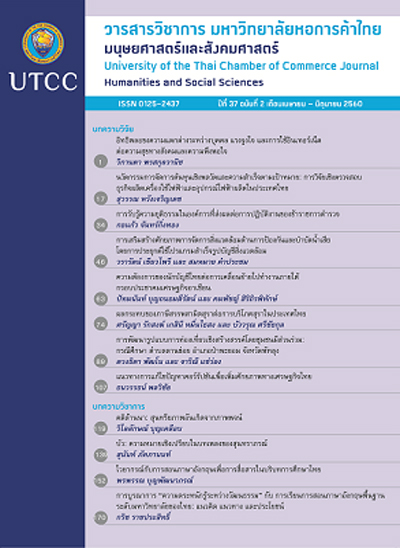การเปิดรับความเสี่ยงจากเงินตราต่างประเทศและผลการดำเนินงาน: การศึกษาเชิงประจักษ์ในตลาดหลักทรัพย์แห่งประเทศไทย
Main Article Content
บทคัดย่อ
งานวิจัยนี้ศึกษาการเปิดรับความเสี่ยงจากเงินตราต่างประเทศ และความสัมพันธ์ของการเปิดรับความเสี่ยงดังกล่าวกับระดับความเกี่ยวพันในการค้าระหว่างประเทศ สภาพคล่องทางการเงิน ระดับการก่อหนี้ และขนาดของกิจการในกลุ่มตัวอย่างที่มียอดขายต่างประเทศซึ่งเป็นบริษัทจดทะเบียนในตลาดหลักทรัพย์แห่งประเทศไทยระหว่าง 2555 ถึง 2557 ทั้งนี้ การศึกษานี้วัดค่าระดับการเปิดรับความเสี่ยงจากเงินตราต่างประเทศจากระดับความอ่อนไหวของการเปลี่ยนแปลงในอัตราแลกเปลี่ยนที่มีต่ออัตราผลตอบแทนของหลักทรัพย์ งานวิจัยนี้พบว่า การเปิดรับความเสี่ยงจากเงินตราต่างประเทศสัมพันธ์กับยอดขายระหว่างประเทศ สภาพคล่องทางการเงิน และระดับการก่อหนี้ระดับการก่อหนี้ในทิศทางเดียวกัน ส่วนขนาดของกิจการมีความสัมพันธ์ในทิศทางตรงกันข้าม ผลการศึกษาสอดคล้องกับการคาดการณ์และผลการวิจัยในอดีตในบริบทต่างประเทศ งานวิจัยนี้ยังแสดงระดับการเปิดรับความเสี่ยงแยกกลุ่มบริษัทตามประเภทอุตสาหกรรมแสดงให้เห็นว่าตัวชี้วัดผลการดำเนินงานมีความสัมพันธ์ที่ต่างกันตามลักษณะการดำเนินงานของกลุ่มอุตสาหกรรม
Article Details
ลิขสิทธิ์ของบทความ
ผลงานที่ได้รับการตีพิมพ์ถือเป็นลิขสิทธิ์ของมหาวิทยาลัยหอการค้าไทย ห้ามมิให้นำเนื้อหา ทัศนะ หรือข้อคิดเห็นใด ๆ ของผลงานไปทำซ้ำ ดัดแปลง หรือเผยแพร่ ไม่ว่าทั้งหมดหรือบางส่วนโดยไม่ได้รับอนุญาตเป็นลายลักษณ์อักษรจากมหาวิทยาลัยหอการค้าไทยก่อน
References
Ahmed, H., Azevedo, A., & Guney, Y. (2014). The effect of hedging of firm value and performance: Evidence from the nonfinancial UK Firms. European Financial Management Association (EFMA) 2014 conference paper. Rome, Italy: EFMA.
Allayannis, G., & Ofek, E. (2001). Exchange rate exposure, hedging, and the use of foreign currency derivatives. Journal of International Money and Finance, 20, 273-296.
Allayannis, G., & Weston, J. P. (2001). The use of foreign currency derivatives and firm market value. The Review of Financial Studies, 14(1), 243-276.
Allayannis, G., Lel, U., & Miller, D.P. (2012). The use of foreign currency derivatives, corporate governance, and firm value around the world. International Economics, 87, 65-79.
Bank of Thailand. (2015). Foreign exchange rate. Retrieved August 20, 2015, from https://www.bot.or.th/Thai/Statistics/FinancialMarkets/ExchangeRate/Pages/ExchangeRate.aspx (in Thai).
Bellone, F., Musso, P., Nesta, L., & Schiavo, S. (2010). Financial constraints and firm export behavior. The World Economy, 33(3), 347-373.
Bodnar, G. M., & Wong, M. H. F. (2003). Estimating exchange rate exposure issues in model structure. Financial Management, 32(1), 35-67.
Choi, J. J., & Prasad, A. M. (1995). Exchange risk sensitivity and its determinants: A firm and industry analysis of U.S. multinationals. Financial Management, 24(3), 77-88.
Chow, E.H., & Chen, H.L. (1998). The determinants of foreign exchange rate exposure: Evidence on Japanese. Pacific-Basin Finance Journal, 6, 153-174.
Clarke, E., & Mefteh, S. (2010). Foreign currency derivatives use, firm value and the effect of the exposure profile: Evidence from France. International Journal of Business, 15(2), 183-196.
Dekle, R., & Ryoo, H. H. (2007). Exchange rate fluctuations, financing constraints, hedging, and exports: Evidence from firm level data. Journal of International Financial Markets, Institutions & Money, 17, 437-451.
Dominguez, K. M. E., & Tesar, L. L. (2001). A re-examination of exchange rate exposure. American Economic Review, 91(2), 369-399.
Dominguez, K. M. E., & Tesar, L. L. (2006). Exchange rate exposure. Journal of international Economics, 68, 188-218.
Guillou, S., & Schiavo, S. (2014). Exchange rate exposure under liquidity constraints. Industrial and Corporate Change, 23(6), 1541-1561.
He, J., & Ng, L.K. (1998). The foreign exchange exposure of Japanese multinational corporations. The Journal of Finance, 53(2), 733-753.
He, J., Ng, L.K., & Wu, X. (1997). Foreign exchange exposure, risk and the Japanese stock market. Hong Kong: University of Hong Kong.
Hunter, D.M. (2005). Time-varying exchange rate exposure of small and large firms. Tampa, FL: University of South Florida.
Ito, T., Koibuchi, S., Sato., K., & Shimizu, J. (2013). Exchange rate exposure and exchange rate risk management: The case of Japanese exporting firms. RIETI Discussion Paper Series, 13(25), 1-22.
Jorion, P. (1990). The exchange-rate exposure of U.S. multinationals. The Journal of Business, 63, 331-345.
Kim, J. H., & Kim, J. (2015). Financial regulation, exchange rate exposure, and hedging activities: Evidence from Korean firms. Emerging Markets Finance & Trade, 51, 152-173.
Kothari, S. P., & Hentschel, L. (2001). Are corporations reducing of taking risks with derivatives? Journal of Financial and Quantitative Analysis, 36(1), 93-118.
Lan, L. H., Chen, C.C., & Chuang, S.S. (2015). Exchange rate risk management: What can we learn from financial crises? Economic Modelling, 45, 187-192.
Magee, S. (2013). The effect of foreign currency hedging on the probability of financial distress. Accounting and Finance, 53, 1107-1127.
Poopat, C. (2007). Fundamental analysis strategy and predictability in the cross-section of Thai stock returns (Unpublished master independent study). Thammasat University, Bangkok, Thailand.
Pramborg, B. (2004). Derivatives hedging, geographical diversification, and firm market value. Journal of Multinational Financial Management, 14, 117-133.
Ritdumrongkul, A. (2011). Derivative activities and Thai banks’ interest rate and exchange rate exposures (Unpublished master independent study). Thammasat University, Bangkok, Thailand.
Rossi, J. L., Junior, & Laham, J. (2008). The impact of hedging on firm value: Evidence from Brazil. Journal of International Finance and Economics, 8, 76-91.
Solakoglu, M. N., & Demir, N. (2009). Exchange-rate exposure and the financial factor. Journal of Economic and Social Research, 11(2), 29-42.
Vathananond, S. (2009). Foreign exchange exposure: Evidence of Thailand foods and beverages industry. The Journal of Social Science, 67, 65-83.
World Bank. (2017). Exports of goods and services. Retrieved March 8, 2018, from https://data.worldbank.org/indicator/NE.EXP.GNFS.ZS?locations=TH
Zhang, X., & Liu, X. (2012). How responsive are Chinese exports to exchange rate changes? Evidence from firm-level data. Journal of Development Studies, 48(10), 1489-1504.

